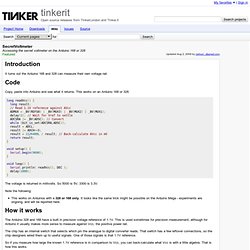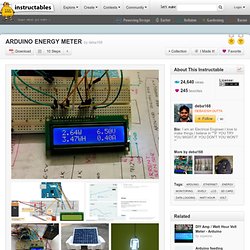

SecretVoltmeter - tinkerit - Accessing the secret voltmeter on the Arduino 168 or 328 - Open source releases from TinkerLondon and Tinker.it. It turns out the Arduino 168 and 328 can measure their own voltage rail.

Copy, paste into Arduino and see what it returns. This works on an Arduino 168 or 328. long readVcc() { long result; // Read 1.1V reference against AVcc ADMUX = _BV(REFS0) | _BV(MUX3) | _BV(MUX2) | _BV(MUX1); delay(2); // Wait for Vref to settle ADCSRA |= _BV(ADSC); // Convert while (bit_is_set(ADCSRA,ADSC)); result = ADCL; result |= ADCH<<8; result = 1126400L / result; // Back-calculate AVcc in mV return result;} void setup() { Serial.begin(9600);} void loop() { Serial.println( readVcc(), DEC ); delay(1000);} The voltage is returned in millivolts. Note the following: Secret Arduino Voltmeter – Measure Battery Voltage.
A little known feature of Arduinos and many other AVR chips is the ability to measure the internal 1.1 volt reference.

This feature can be exploited to improve the accuracy of the Arduino function – analogRead() when using the default analog reference. It can also be used to measure the Vcc supplied to the AVR chip, which provides a means of monitoring battery voltage without using a precious analog pin to do so. I first learned of this technique from these articles – Making accurate ADC readings on the Arduino, and Secret Voltmeter. In this article, I have incorporated some additional improvements. Motivation There are at least two reasons to measure the voltage supplied to our Arduino (Vcc). ARDUINO ENERGY METER. I belong to a village of Odisha, India where frequent power cut is very common.

It hampers the life of every one. During my childhood days continuing studies after dusk was a real challenge. Due to this problem I designed a solar system for my home on a experimental basis. I used a solar panel of 10 Watt ,6V for lighting few bright LEDs. After facing lot of hardships the project was successful. DIY Amp / Watt Hour Volt Meter - Arduino. I've changed the resistor values of the voltage divider to get a better impedence match with the Arduino A/D.

Ben from Pololu says: The ADC on an AVR can't very accurately measure signals with a high output impedance, and your voltage divider definitely counts as high-impedance. From the ATmega328P datasheet: The ADC is optimized for analog signals with an output impedance of approximately 10 kΩ or less. If such a source is used, the sampling time will be negligible. I think you'll have better results if you make your voltage divider resistors smaller, such as 10k and 5k, though this would waste 10 times more power (maybe 1.6 mW for your current configuration vs 17 mW for the new one). The Arduino can accept up to 5v on a analog input. The code to read that value is as follows: batteryVoltage = pinVoltage * ratio; // Use the ratio calculated for the voltage divider // to calculate the battery voltage.
Volt Amp Watt Hour Meter Shield. A while back I designed a watt hour meter for tracking power produced by solar or wind, power consumed by loads, and power contained in a battery bank.

I have produced a new version built on the Sparkfun Protoshield. This one uses a ACS712 (5 amp) current sensor, and is designed to monitor up to 10vdc. Different current sensors and resistors can be installed for other current and voltage ranges. LEVEL Logic Level Converter Module Quickstart Guide. The Logic Level Converter Module provides a bidirectional interface between devices operating at different voltages.

The typical application is use of 3.3V sensors or devices with a 5V microcontroller such as an Arduino. Up to 4 digital I/O lines can be converted. Module Pinout. Low-Power Wireless Sensor Node. My goal today is to create a sensor node which can be used in a wireless sensor network, to capture environmental information and send it back to the base. My main goals are for the nodes to: Be cheap, and last for a year. How cheap and how low-power can we go? Voltage monitor for car’s battery and its charging system. My 2010 Equinox has got every feature that a modern automobile should have.

However, one thing that I personally find missing is the real-time monitoring of voltage across the car’s battery terminals. This may not seem to be that important but one of the most common reasons for a car battery failure is the faulty charging system. If the charging system is not working properly, the battery will not get the proper charging voltage (about 13.8 V for 12V battery) across its terminals and it could go flat.
This project is about making a simple electronic voltage monitor system for car’s battery and its charging system. It plugs into the car’s cigarette lighter receptacle and displays the instantaneous output voltage across the battery terminals on a 4-digit seven segment LED display. Car's battery and charging system voltage monitoring device Theory Functional block diagram of car battery monitor system Circuit diagram The circuit diagram of this project is shown below.